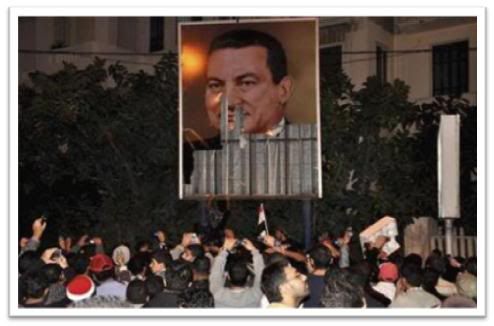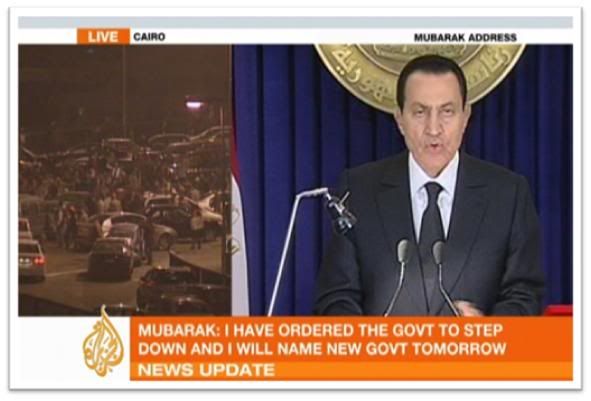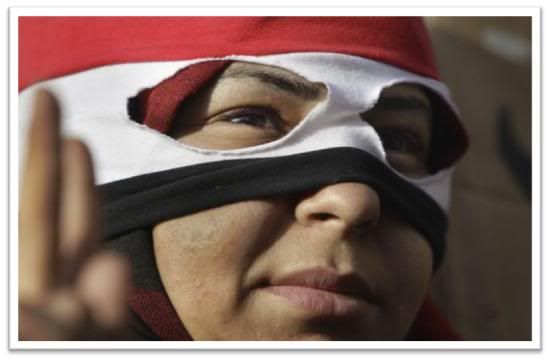EGYPTIAN UPRISING: A TIMELINE
 By Kiana AshtianiStaff WriterVoicing their anger and dissatisfaction with the 30-year rule of President Hosni Mubarak, Egyptians across the country fill the street, not lead by any particular party, group or ideology, call for Mubarak to step down. Mubarak first assumed office in 1981, after the assassination of then-President Anwar Sadat. For three decades, Mubarak has had the country under Emergency Law, first enacted in 1967. Yet, since 1981, Mubarak has continuously extended its provisions. As a leader of a questionably semi-democratic system, Mubarak has also been accused of corruption and fraudulent elections which have constantly resulted in his re-election. The United States and many European governments view Mubarak as crucial for maintaining stability in the Middle East, in particular with Israel. Mubarak’s son, Gamal Mubarak, is suspected of being groomed to continue his father’s legacy as president.January 25Beginning as a protest on the day commemorating the controversial police forces on January 25th, thousands of Egyptians marched into downtown Cairo, particularly Tahrir Square, chanting “Down with Mubarak”. These protesters and their counterparts in Alexandria, Mansura, Suez and Tanta, clashed with police. The government blamed Egypt’s largest and oldest Islamist group, the Muslim Brotherhood, who immediately denied involvement.
By Kiana AshtianiStaff WriterVoicing their anger and dissatisfaction with the 30-year rule of President Hosni Mubarak, Egyptians across the country fill the street, not lead by any particular party, group or ideology, call for Mubarak to step down. Mubarak first assumed office in 1981, after the assassination of then-President Anwar Sadat. For three decades, Mubarak has had the country under Emergency Law, first enacted in 1967. Yet, since 1981, Mubarak has continuously extended its provisions. As a leader of a questionably semi-democratic system, Mubarak has also been accused of corruption and fraudulent elections which have constantly resulted in his re-election. The United States and many European governments view Mubarak as crucial for maintaining stability in the Middle East, in particular with Israel. Mubarak’s son, Gamal Mubarak, is suspected of being groomed to continue his father’s legacy as president.January 25Beginning as a protest on the day commemorating the controversial police forces on January 25th, thousands of Egyptians marched into downtown Cairo, particularly Tahrir Square, chanting “Down with Mubarak”. These protesters and their counterparts in Alexandria, Mansura, Suez and Tanta, clashed with police. The government blamed Egypt’s largest and oldest Islamist group, the Muslim Brotherhood, who immediately denied involvement. January 26The second day of protests saw the use of gun fire and reports say that as many as 55 people were injured in Suez, the scene of the bloodiest clashes with police.January 27Protests continued strong as Egypt saw the arrival of Mohamed ElBaradei, the former director general of the International Atomic Energy Agency (IAEA) and Nobel Peace Prize winner. Prior to the protests, many Egyptians and members of oppositional parties advocated for ElBaradei to run in the presidential elections. Joining the mass protests in Cairo, ElBaradei is seen as an unofficial leader of the uprising and possible leader of a transition government if Mubarak is either removed or voluntarily steps down.
January 26The second day of protests saw the use of gun fire and reports say that as many as 55 people were injured in Suez, the scene of the bloodiest clashes with police.January 27Protests continued strong as Egypt saw the arrival of Mohamed ElBaradei, the former director general of the International Atomic Energy Agency (IAEA) and Nobel Peace Prize winner. Prior to the protests, many Egyptians and members of oppositional parties advocated for ElBaradei to run in the presidential elections. Joining the mass protests in Cairo, ElBaradei is seen as an unofficial leader of the uprising and possible leader of a transition government if Mubarak is either removed or voluntarily steps down.
January 28On the fourth day of protests, the Egyptian government unplugged its 80 million citizens from the Internet, shutting down access to social networks such as Facebook and Twitter, which have been popular and effective in previous uprisings in Iran's contested presidential election in 2009 and most recently during the uprisings in Tunisia. Most cell phone networks were also disrupted, yet Egyptians managed to send their videos and photos for the world to see and continued to protest across the country. Clashes with police continue as deaths and hundred of injuries are reported.
Later that day, Mubarak announces that he will dismiss his government in order to appease the unhappy population, but his own resignation is not mentioned. His changes include the appointment of Omar Suleiman, Director of the Egyptian General Intelligence Directorate, as the first Vice President of Mubarak’s regime. This attempt to change the government failed to suppress the uprisings and Egyptians begin to voice their anger towards the United States government, which they believe is maintaining Mubarak’s rule through foreign aid and has not been active and vocal enough in inducing Mubarak to step down. The U.S., it seems, is most concerned with the creation of a power vacuum if Mubarak abruptly leaves or is removed for various opportunists. With the lack of police presence, local enforcement has fallen into the hands of individual Egyptians and vigilante groups. Rumors in Egypt claim that the government have purposely allowed for the chaos to grow without the protection from the police in order to punish the demonstrators.
 January 29
January 29
Egyptian soldiers and civilians stand hand-in-hand around Cairo's famed antiquities museum early in the day, protecting thousands of priceless artifacts, including the gold mask of King Tutankhamun, from looters. Later on in the day thousands of anti-government protesters in Tahrir Square stand, despite fire from troops. U.S. and European governments advise their citizens staying in Egypt to consider leaving as soon as possible.January 30President Hosni Mubarak still refuses to step down, regardless of the growing calls for his resignation. Protesters continue to defy the military-imposed curfew across Egypt and thousands remain gathered in Cairo's Tahrir Square. Hundreds of others have marched through Alexandria. Opposition groups continue to call for a "million man march" and a general strike to commemorate one week since the protest movement began. Internet access across Egypt is still unreliable and international investors continue withdrawing significant capital from Egypt amid rising unrest, while economists predict a long term economic backlash as a result of the uprising. February 1Protesters in Tahrir square swelled to more than a million people and thousands more throughout Egypt, including in Alexandria and Suez. Khalid Abdel Nasser, son of the former Egyptian president Gamal Abdel Nasser, joined the protest in Tahrir Square. Meanwhile, Mubarak announces in a televised address that he will not run for re-election, but refused to step down from office. ElBaradei, now labeled as the opposition figure, returned to Cairo to take part in the protests criticizing Mubarak’s unwillingness to step down immediately. After his speech, clashes broke out between pro-Mubarak and anti-government protesters in Alexandria.February 2For much of Wednesday there were violent clashes around Tahrir Square. Nearly 1,500 people were injured and at least three deaths were reported by the Reuters news agency. Reports claim that the military allowed thousands of pro-Mubarak supporters, armed with sticks and knives, to enter the square.February 4Once again, as the country enters its eleventh day of unrest and mass demonstrations, hundreds of thousands of anti-government protesters gather in Cairo's Tahrir Square for what they have termed the "Day of Departure," chanting for Mubarak to leave. Iran's top leader, Ayatollah Khamenei, says during Friday prayers that the uprisings in Egypt and Tunisia are a sign of "Islamic awareness" in the region.February 5Thousands remain inside Tahrir Square, fearing an approaching attempt by the military to evacuate the square. According to the Egyptian health minister, 11 people have died, while the United Nations says 300 people may have been killed across the country since protests began. The Egyptian uprising is a continuing story with news constantly filtering through major news networks and social media. With similar developments in Tunisia this month, where mass protests pushed Zine El Abidine Ben Ali to step down and flee the country on January 14th, it is undeniable that the Tunisian movement inspired the Egyptians who before January 25th were chanting “Ben Ali take Mubarak with you”. As the story develops it is important to ask whether Egypt will be successful or if it will eventually fizzle as police suppression and fear increases. It is clear that unlike the Iranian protests in June 2009, that there is more widespread dislike of Mubarak at almost every level of Egyptian society. While there were mass protests in Iran consisting mostly of the middle class and youth, there was still strong support for the government, which has some democratic elements and whose government structure of power varies significantly with Egypt--with Mubarak holding significantly more power than the Iranian president.The question of whether the momentum of the unprecedented and awe-inspiring dissent can be maintained depends on how Egyptians react to the threat of violence in the absence of police protection. Many Egyptians have now returned to their daily life and the media suggests that the revolutionary fervor has dispersed. Yet, not all revolutions have been overnight and not all popular uprisings result in a revolution in a classical sense. Furthermore, it is important to recall that although massive protesting may fade into smaller demonstrations, Egyptians will not forget their ultimate goal and demands. These protests against injustice will continue in their everyday lives and Egypt can never be the same now that the whole world is watching. Although chaos seems to reign, these are days of hope for Egypt and its future for peace and fair elections.Main photo courtesy of Gigi Ibrahim.
February 1Protesters in Tahrir square swelled to more than a million people and thousands more throughout Egypt, including in Alexandria and Suez. Khalid Abdel Nasser, son of the former Egyptian president Gamal Abdel Nasser, joined the protest in Tahrir Square. Meanwhile, Mubarak announces in a televised address that he will not run for re-election, but refused to step down from office. ElBaradei, now labeled as the opposition figure, returned to Cairo to take part in the protests criticizing Mubarak’s unwillingness to step down immediately. After his speech, clashes broke out between pro-Mubarak and anti-government protesters in Alexandria.February 2For much of Wednesday there were violent clashes around Tahrir Square. Nearly 1,500 people were injured and at least three deaths were reported by the Reuters news agency. Reports claim that the military allowed thousands of pro-Mubarak supporters, armed with sticks and knives, to enter the square.February 4Once again, as the country enters its eleventh day of unrest and mass demonstrations, hundreds of thousands of anti-government protesters gather in Cairo's Tahrir Square for what they have termed the "Day of Departure," chanting for Mubarak to leave. Iran's top leader, Ayatollah Khamenei, says during Friday prayers that the uprisings in Egypt and Tunisia are a sign of "Islamic awareness" in the region.February 5Thousands remain inside Tahrir Square, fearing an approaching attempt by the military to evacuate the square. According to the Egyptian health minister, 11 people have died, while the United Nations says 300 people may have been killed across the country since protests began. The Egyptian uprising is a continuing story with news constantly filtering through major news networks and social media. With similar developments in Tunisia this month, where mass protests pushed Zine El Abidine Ben Ali to step down and flee the country on January 14th, it is undeniable that the Tunisian movement inspired the Egyptians who before January 25th were chanting “Ben Ali take Mubarak with you”. As the story develops it is important to ask whether Egypt will be successful or if it will eventually fizzle as police suppression and fear increases. It is clear that unlike the Iranian protests in June 2009, that there is more widespread dislike of Mubarak at almost every level of Egyptian society. While there were mass protests in Iran consisting mostly of the middle class and youth, there was still strong support for the government, which has some democratic elements and whose government structure of power varies significantly with Egypt--with Mubarak holding significantly more power than the Iranian president.The question of whether the momentum of the unprecedented and awe-inspiring dissent can be maintained depends on how Egyptians react to the threat of violence in the absence of police protection. Many Egyptians have now returned to their daily life and the media suggests that the revolutionary fervor has dispersed. Yet, not all revolutions have been overnight and not all popular uprisings result in a revolution in a classical sense. Furthermore, it is important to recall that although massive protesting may fade into smaller demonstrations, Egyptians will not forget their ultimate goal and demands. These protests against injustice will continue in their everyday lives and Egypt can never be the same now that the whole world is watching. Although chaos seems to reign, these are days of hope for Egypt and its future for peace and fair elections.Main photo courtesy of Gigi Ibrahim.